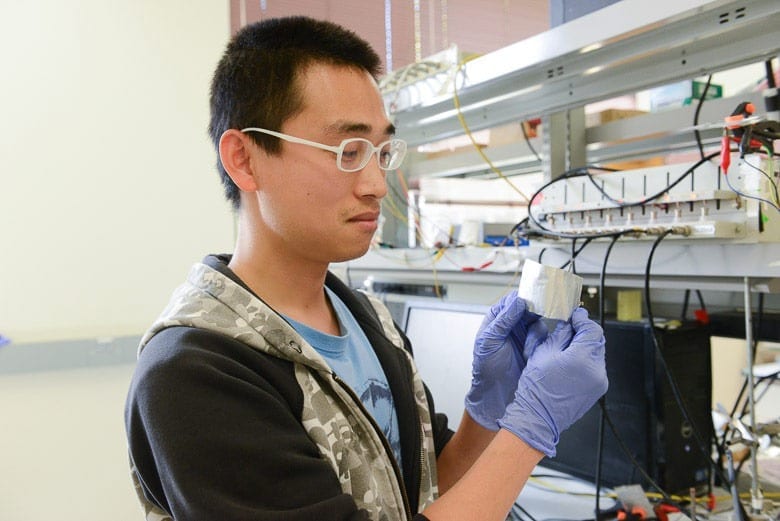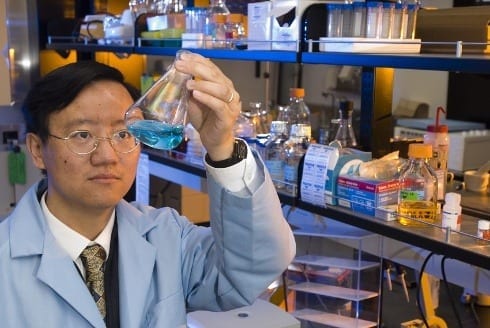
The new aluminum-ion battery could replace many of the lithium-ion and alkaline batteries in wide use today
Stanford University scientists have invented the first high-performance aluminum battery that’s fast-charging, long-lasting and inexpensive. Researchers say the new technology offers a safe alternative to many commercial batteries in wide use today.
“We have developed a rechargeable aluminum battery that may replace existing storage devices, such as alkaline batteries, which are bad for the environment, and lithium-ion batteries, which occasionally burst into flames,” said Hongjie Dai, a professor of chemistry at Stanford. “Our new battery won’t catch fire, even if you drill through it.”
Dai and his colleagues describe their novel aluminum-ion battery in “An ultrafast rechargeable aluminum-ion battery,” which will be published in the April 6 advance online edition of the journal Nature.
Aluminum has long been an attractive material for batteries, mainly because of its low cost, low flammability and high-charge storage capacity. For decades, researchers have tried unsuccessfully to develop a commercially viable aluminum-ion battery. A key challenge has been finding materials capable of producing sufficient voltage after repeated cycles of charging and discharging.
Graphite cathode
An aluminum-ion battery consists of two electrodes: a negatively charged anode made of aluminum and a positively charged cathode.
“People have tried different kinds of materials for the cathode,” Dai said. “We accidentally discovered that a simple solution is to use graphite, which is basically carbon. In our study, we identified a few types of graphite material that give us very good performance.”
For the experimental battery, the Stanford team placed the aluminum anode and graphite cathode, along with an ionic liquid electrolyte, inside a flexible polymer- coated pouch.
“The electrolyte is basically a salt that’s liquid at room temperature, so it’s very safe,” said Stanford graduate student Ming Gong, co-lead author of the Nature study.
Aluminum batteries are safer than conventional lithium-ion batteries used in millions of laptops and cell phones today, Dai added.
“Lithium-ion batteries can be a fire hazard,” he said.
As an example, he pointed to recent decisions by United and Delta airlines to ban bulk lithium-battery shipments on passenger planes.
“In our study, we have videos showing that you can drill through the aluminum battery pouch, and it will continue working for a while longer without catching fire,” Dai said. “But lithium batteries can go off in an unpredictable manner – in the air, the car or in your pocket. Besides safety, we have achieved major breakthroughs in aluminum battery performance.”
One example is ultra-fast charging. Smartphone owners know that it can take hours to charge a lithium-ion battery. But the Stanford team reported “unprecedented charging times” of down to one minute with the aluminum prototype.
Read more: Aluminum battery from Stanford offers safe alternative to conventional batteries
The Latest on: Aluminium–air battery
[google_news title=”” keyword=”Aluminium–air battery” num_posts=”10″ blurb_length=”0″ show_thumb=”left”]
via Google News
The Latest on: Aluminium–air battery
- Innovative New Tech is Transforming the Battery Marketon May 7, 2024 at 8:00 am
The battery market is brimming with game-changing innovations, promising higher energy density, faster charging, and greener production methods.
- A Company Is Building a Giant Compressed-Air Battery in the Australian Outbackon May 4, 2024 at 12:00 am
Most lithium-ion battery systems run for a maximum of four hours. Energy system planners have said the grid will also need storage options that can run six, eight, and 12 hours, and some that last ...
- Cornell ChemE Car Races Ahead in Model Car Competitionon May 2, 2024 at 11:22 am
Cornell ChemE Car is a competition-based project team that competes annually at both regional and national competitions. The team excels in competitions, having placed in the top two at regionals for ...
- Breakthrough Paper-Based Battery Design Draws Inspiration from Plantson April 14, 2024 at 10:00 am
The paper battery achieves an open circuit voltage of 1.8 volts, a 1.0-volt current density of 100 mA/cm², and a maximum output of 103 milliwatts/cm². The battery is eco-friendly, using carbon ...
- Apple MacBook Air M3 review: the laptop to beaton April 7, 2024 at 11:03 pm
Faster chip, tremendous battery life, premium touch points and a price cut make the best even better Apple’s latest MacBook Air adds more power to an already potent package while maintaining its ...
- Panasonic, IOC form JV to make li-ion batteries in Indiaon March 31, 2024 at 9:49 am
The company has a venture with Phinergy, an Israeli start-up specialising in hybrid li-ion and aluminium-air/zinc-air battery systems. Panasonic already has a footprint in India’s energy ...
- The 7 Best Power Banks to Keep Your Gadgets Goingon June 14, 2023 at 9:27 pm
What about suddenly realizing you’re down to your last 10 percent of battery life while camping or hiking? You’re not alone. These days, it’s increasingly challenging to stay charged when we ...
- Pioneering indigenous battery technologieson April 18, 2023 at 8:41 pm
The team initially focused on aluminium air fuel cells (Al-AFCs), instead of ... In 2019, Log9 developed its first EV battery (test pack). And the year after, it launched the fast-charging RapidX ...
- Next-generation battery technologies and trendson June 20, 2022 at 2:07 pm
In 2014, an electric car hit a range of 1,000 miles on a single charge. The battery technology behind this feat was aluminium-air, which uses naturally occurring oxygen to fill its cathode and thus ...
- Stealing Joules From An Aluminium-Air Batteryon July 28, 2017 at 6:11 am
Experimenting with a few configurations, Hackaday.io user [will.stevens] has assembled an aluminium-air battery and combined it with a joule thief to light an LED. To build the air battery ...
via Bing News










